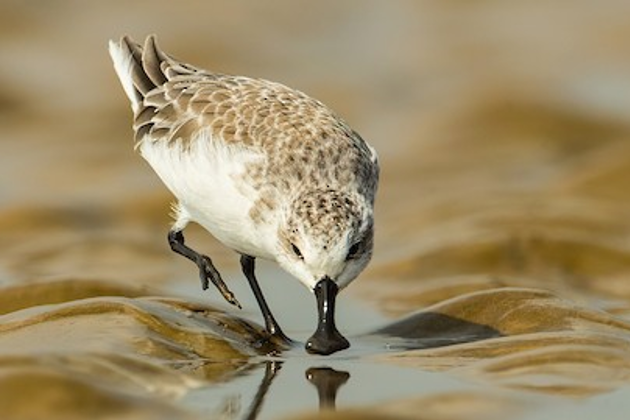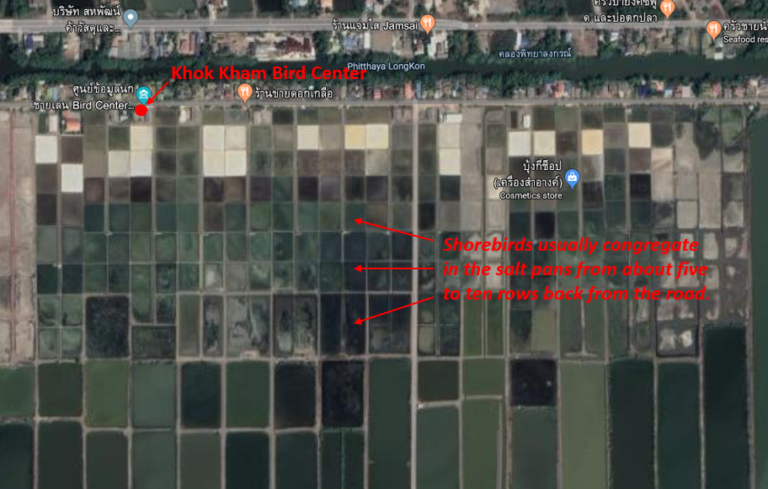Khok Kham, Samut Sakhon, Thailand

The most accessible location where Spoon-billed Sandpiper has been seen reliably in recent years is a set of salt pans about 30 km southwest of Bangkok. This population is tiny, precariously clinging to existence, and bands show that the same handful of individuals return to winter in the same salt pans year after year. The operators of a local salt farming operation have established the Khok Kham Bird Center, which is dedicated to awareness of the shorebirds that winter in the area, especially its icon, the Spoon-billed Sandpiper.
Orientation
Directions
Khok Kham is on the outskirts of Samut Sakhon, a densely populated satellite city of Bangkok. The most direct route routes from Bangkok is to take the freeway, Route 35 west and turn south onto Bang Khun Thian – Chai Tha Le Road. This secondary highway leads from the congested urban corridor out to a set of rural coastal communities, including Khok Kham, passing many lagoons, several of which have large seafood restaurants constructed on pilings over the water.
After 15 km, the highway bends westward and becomes Route 4008, which runs along the north side of a large canal, Phittaya Long Kon. Remain on Route 4008 for 4.4. km, then turn south onto a bridge over the canal, turn west to parallel the south side of the canal for another 3.9 km to reach the Khok Kham Bird Center, and park in the small dirt lot behind it.
Birdfinding
Khok Kham is predominantly a shorebird site, with just a few other open-country and wetland birds. Most shorebird activity is usually found in the mid-sized salt pans about five-to-ten rows back from the road. After parking in the lot at the Bird Center, if nobody is nearby, carefully walk back on the small dykes between the pans, always scanning to locate the shorebird flocks and avoid flushing them prematurely.
In winter, the shorebirds present in large flocks will be mostly Lesser Sand Plover, Black-tailed Godwit, Red-necked Stint, and Curlew and Marsh Sandpipers.

Spoon-billed Sandpiper winters regularly in very small numbers at Khok Kham. © Lefei Han

Large flocks of Curlew Sandpiper winter at Khok Kham. © Ryan Sanderson

Broad-billed Sandpiper winters in small numbers at Khok Kham. © Ted Keyel
Those typically present in smaller numbers include Black-winged Stilt, Gray (i.e., Black-bellied), Pacific Golden-, Greater Sand, Little Ringed, and Kentish Plovers, Asian Dowitcher, Ruddy Turnstone, Long-toed Stint, Great Knot, Dunlin, Sanderling, Broad-billed, Spoon-billed, Common, and Wood Sandpipers, Common Redshank, and Common Greenshank.
Apart from migratory shorebirds, other species often found in winter around the salt pans or flying over include Brown-headed Gull, Little and Whiskered Terns, Little and Indian Cormorants, Gray Heron, Chinese and Javan Pond-Herons, Great, Intermediate, and Little Egrets, and Painted Stork.

Large flocks of Red-necked Stints winter at Khok Kham, with a few Spoon-billed Sandpipers mixed in. © Sahana M.

Notes
When to Visit
Seasonally. Most of the sought-after species for which Khok Kham is known are migrants and winter visitors. Spoon-billed Sandpiper, clearly the top prize, is present mainly from late October to early April. A few individuals of some migratory species may be present at any time of year, but the site is mostly empty from May into July.
Daily. The shorebird flocks spend much of each day in the salt pans, but not all of it. They are mobile and at low tide they typically commute out to the exposed mudflats along the coast about 3 km south. So it is advisable to obtain some advance intelligence about the current timing of low and high tides and aim to arrive as the tide is approaching the high side of a cycle. However, the Gulf of Siam has unusual tidal rhythms that do not conform to the 12-and-a-half-hour cycles that prevail along most of the world’s coastlines, so precision timing is not always possible.
Links